run flat MINI Hardtop 2 Door 2005 Owner's Manual
[x] Cancel search | Manufacturer: MINI, Model Year: 2005, Model line: Hardtop 2 Door, Model: MINI Hardtop 2 Door 2005Pages: 165, PDF Size: 2.32 MB
Page 5 of 165
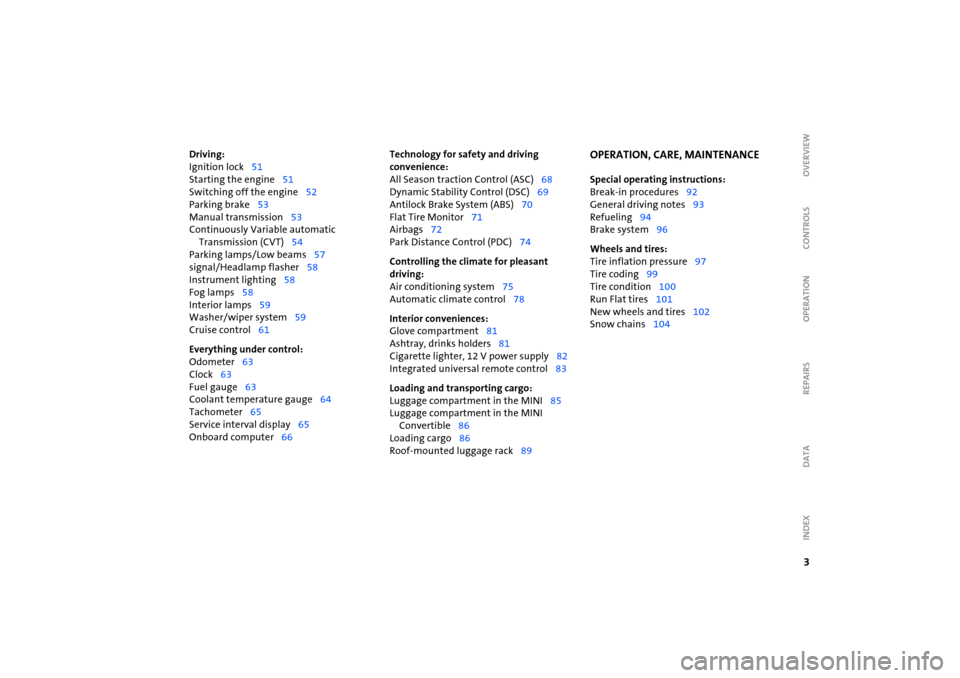
3OVERVIEW REPAIRS OPERATION CONTROLS DATA INDEX
Driving:Ignition lock
51
Starting the engine
51
Switching off the engine
52
Parking brake
53
Manual transmission
53
Continuously Variable automatic
Transmission (CVT)
54
Parking lamps/Low beams
57
signal/Headlamp flasher
58
Instrument lighting
58
Fog lamps
58
Interior lamps
59
Washer/wiper system
59
Cruise control
61
Everything under control:Odometer
63
Clock
63
Fuel gauge
63
Coolant temperature gauge
64
Tachometer
65
Service interval display
65
Onboard computer
66
Technology for safety and driving
convenience:All Season traction Control (ASC)
68
Dynamic Stability Control (DSC)
69
Antilock Brake System (ABS)
70
Flat Tire Monitor
71
Airbags
72
Park Distance Control (PDC)
74
Controlling the climate for pleasant
driving:Air conditioning system
75
Automatic climate control
78
Interior conveniences:Glove compartment
81
Ashtray, drinks holders
81
Cigarette lighter, 12 V power supply
82
Integrated universal remote control
83
Loading and transporting cargo:Luggage compartment in the MINI
85
Luggage compartment in the MINI Convertible
86
Loading cargo
86
Roof-mounted luggage rack
89
OPERATION, CARE, MAINTENANCESpecial operating instructions:Break-in procedures
92
General driving notes
93
Refueling
94
Brake system
96
Wheels and tires:Tire inflation pressure
97
Tire coding
99
Tire condition
100
Run Flat tires
101
New wheels and tires
102
Snow chains
104
Page 43 of 165
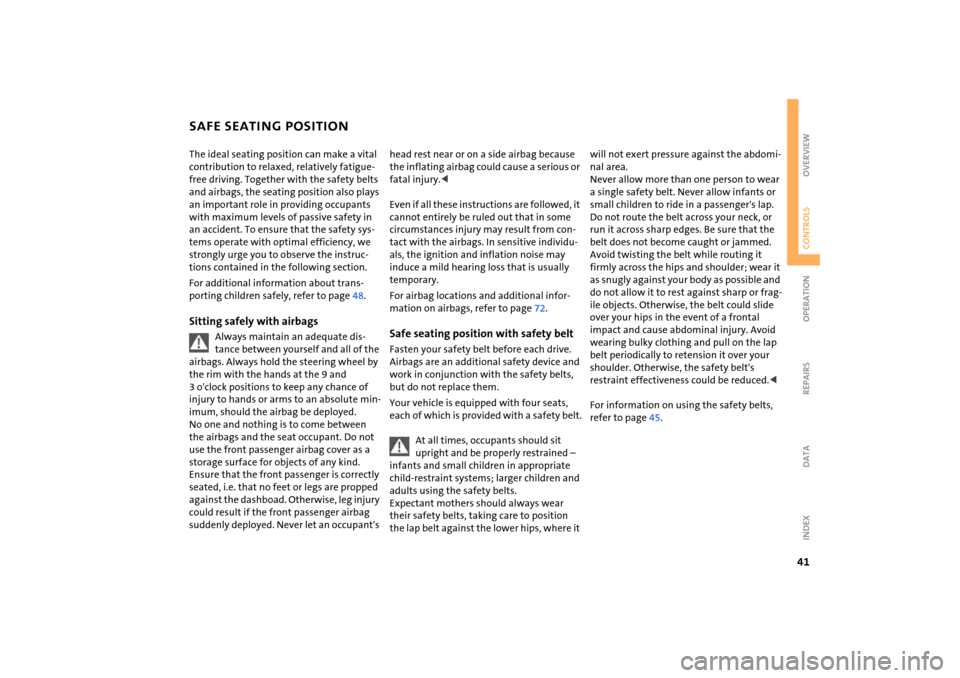
41
OVERVIEW REPAIRS OPERATIONCONTROLS DATA INDEX
SAFE SEATING POSITIONThe ideal seating position can make a vital
contribution to relaxed, relatively fatigue-
free driving. Together with the safety belts
and airbags, the seating position also plays
an important role in providing occupants
with maximum levels of passive safety in
an accident. To ensure that the safety sys
-
tems operate with optimal efficiency, we
strongly urge you to observe the instruc
-
tions contained in the following section.For additional information about trans
-
porting children safely, refer to page
48.
Sitting safely with airbags
Always maintain an adequate dis
-
tance between yourself and all of the
airbags. Always hold the steering wheel by
the rim with the hands at the 9 and
3
o'clock positions to keep any chance of
injury to hands or arms to an absolute min
-
imum, should the airbag be deployed.
No one and nothing is to come between
the airbags and the seat occupant. Do not
use the front passenger airbag cover as a
storage surface for objects of any kind.
Ensure that the front passenger is correctly
seated, i.e. that no feet or legs are propped
against the dashboad. Otherwise, leg injury
could result if the front passenger airbag
suddenly deployed. Never let an occupant's
head rest near or on a side airbag because
the inflating airbag could cause a serious or
fatal injury.
circumstances injury may result from con
-
tact with the airbags. In sensitive individu
-
als, the ignition and inflation noise may
induce a mild hearing loss that is usually
temporary. For airbag locations and additional infor
-
mation on airbags, refer to page
72.
Safe seating position with safety belt Fasten your safety belt before each drive.
Airbags are an additional safety device and
work in conjunction with the safety belts,
but do not replace them.Your vehicle is equipped with four seats,
each of which is provided with a safety belt.
At all times, occupants should sit upright and be properly restrained –
infants and small children in appropriate
child-restraint systems; larger children and
adults using the safety belts.
Expectant mothers should always wear
their safety belts, taking care to position
the lap belt against the lower hips, where it
will not exert pressure against the abdomi
-
nal area.
Never allow more than one person to wear
a single safety belt. Never allow infants or
small children to ride in a passenger's lap.
Do not route the belt across your neck, or
run it across sharp edges. Be sure that the
belt does not become caught or jammed.
Avoid twisting the belt while routing it
firmly across the hips and shoulder; wear it
as snugly against your body as possible and
do not allow it to rest against sharp or frag
-
ile objects. Otherwise, the belt could slide
over your hips in the event of a frontal
impact and cause abdominal injury. Avoid
wearing bulky clothing and pull on the lap
belt periodically to retension it over your
shoulder. Otherwise, the safety belt's
restraint effectiveness could be reduced.
45.
Page 74 of 165
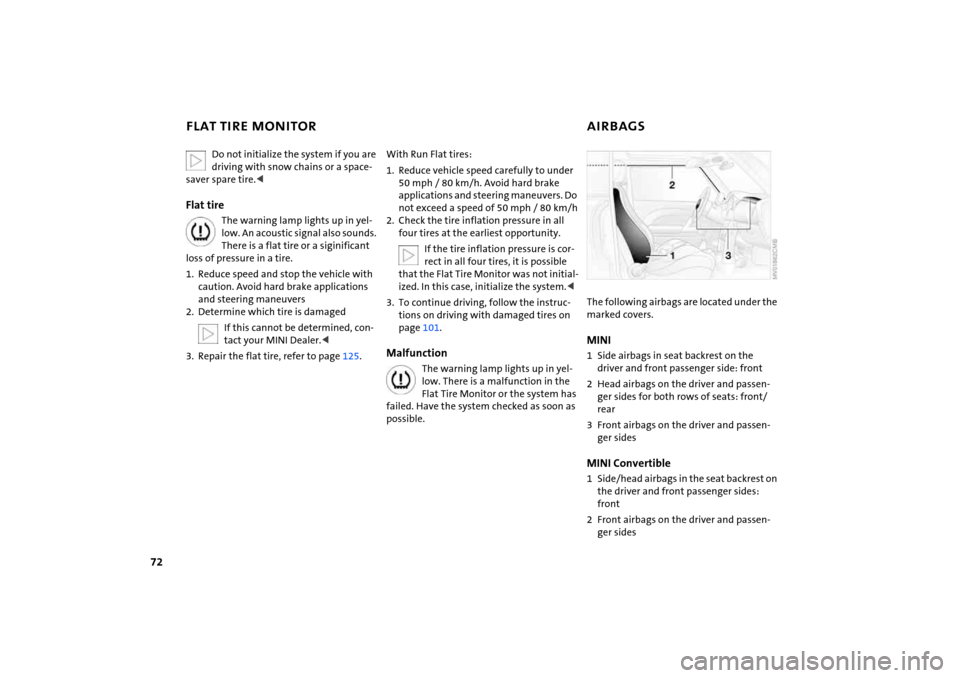
72
FLAT TIRE MONITOR
AIRBAGS
Do not initialize the system if you are driving with snow chains or a space-
saver spare tire.<
Flat tire
The warning lamp lights up in yel
-
low. An acoustic signal also sounds.
There is a flat tire or a siginificant
loss of pressure in a tire.
1. Reduce speed and stop the vehicle with
caution. Avoid hard brake applications
and steering maneuvers2. Determine which tire is damaged
If this cannot be determined, con
-
tact your MINI Dealer.<
3. Repair the flat tire, refer to page
125
.
With Run Flat tires:1. Reduce vehicle speed carefully to under
50
mph
/ 80 km/h. Avoid hard brake
applications and steering maneuvers. Do
not exceed a speed of 50
mph
/ 80
km/h
2. Check the tire inflation pressure in all
four tires at the earliest opportunity.
If the tire inflation pressure is cor
-
rect in all four tires, it is possible
that the Flat Tire Monitor was not initial
-
ized. In this case, initialize the system.<
3. To continue driving, follow the instruc
-
tions on driving with damaged tires on
page
101
.
Malfunction
The warning lamp lights up in yel
-
low. There is a malfunction in the
Flat Tire Monitor or the system has
failed. Have the system checked as soon as
possible.
The following airbags are located under the marked covers.MINI 1 Side airbags in seat backrest on the
driver and front passenger side: front2 Head airbags on the driver and passen
-
ger sides for both rows of seats: front/
rear3 Front airbags on the driver and passen
-
ger sidesMINI Convertible1 Side/head airbags in the seat backrest on
the driver and front passenger sides:
front2 Front airbags on the driver and passen
-
ger sides
Page 99 of 165
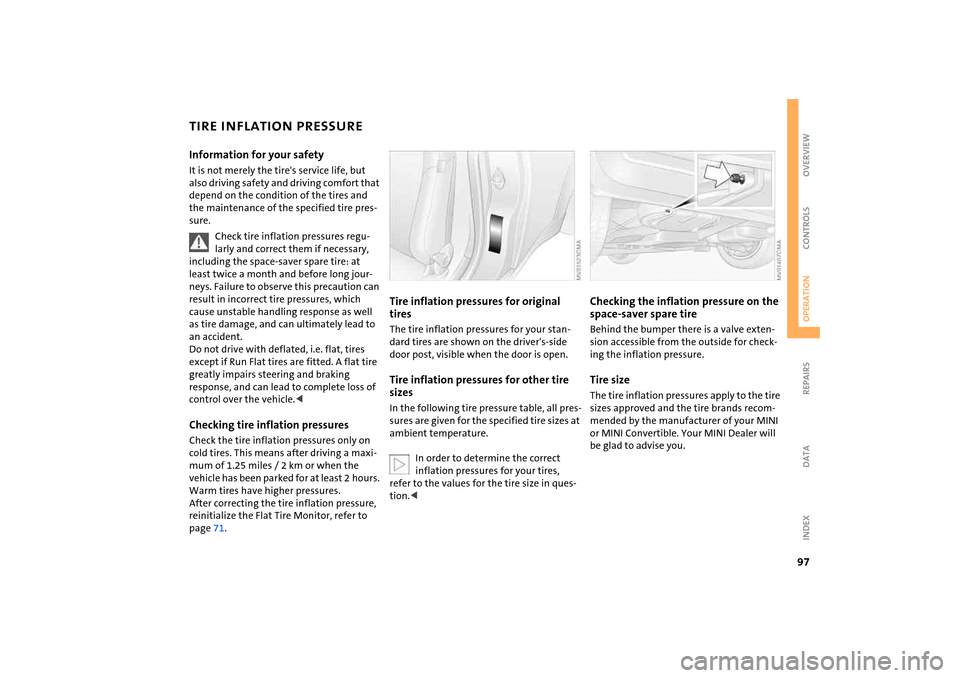
97
OVERVIEW REPAIRSOPERATIONCONTROLS DATA INDEX
TIRE INFLATION PRESSURE Information for your safetyIt is not merely the tire's service life, but
also driving safety and driving comfort that
depend on the condition of the tires and
the maintenance of the specified tire pres
-
sure.
Check tire inflation pressures regu
-
larly and correct them if necessary,
including the space-saver spare tire: at
least twice a month and before long jour
-
neys. Failure to observe this precaution can
result in incorrect tire pressures, which
cause unstable handling response as well
as tire damage, and can ultimately lead to
an accident.
Do not drive with deflated, i.e. flat, tires
except if Run Flat tires are fitted. A flat tire
greatly impairs steering and braking
response, and can lead to complete loss of
control over the vehicle.
-
mum of 1.25
miles / 2
km or when the
vehicle has been parked for at least 2
hours.
Warm tires have higher pressures.
After correcting the tire inflation pressure,
reinitialize the Flat Tire Monitor, refer to
page
71.
Tire inflation pressures for original tiresThe tire inflation pressures for your stan
-
dard tires are shown on the driver's-side
door post, visible when the door is open.Tire inflation pressures for other tire
sizesIn the following tire pressure table, all pres
-
sures are given for the specified tire sizes at
ambient temperature.
In order to determine the correct inflation pressures for your tires,
refer to the values for the tire size in ques
-
tion.<
Checking the inflation pressure on the space-saver spare tireBehind the bumper there is a valve exten
-
sion accessible from the outside for check
-
ing the inflation pressure.Tire sizeThe tire inflation pressures apply to the tire
sizes approved and the tire brands recom
-
mended by the manufacturer of your MINI
or MINI Convertible. Your MINI Dealer will
be glad to advise you.
Page 102 of 165
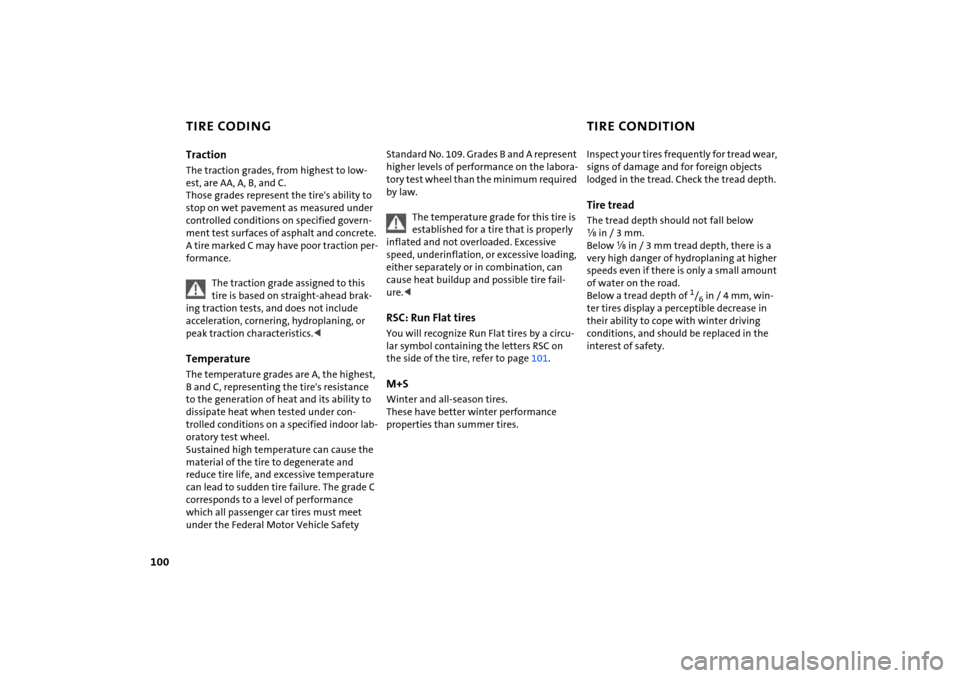
100
TIRE CODING
TIRE CONDITION
Traction The traction grades, from highest to low
-
est, are AA, A, B, and C.
Those grades represent the tire's ability to
stop on wet pavement as measured under
controlled conditions on specified govern
-
ment test surfaces of asphalt and concrete.
A tire marked C may have poor traction per
-
formance.
The traction grade assigned to this tire is based on straight-ahead brak
-
ing traction tests, and does not include
acceleration, cornering, hydroplaning, or
peak traction characteristics.
to the generation of heat and its ability to
dissipate heat when tested under con
-
trolled conditions on a specified indoor lab
-
oratory test wheel.
Sustained high temperature can cause the
material of the tire to degenerate and
reduce tire life, and excessive temperature
can lead to sudden tire failure. The grade C
corresponds to a level of performance
which all passenger car tires must meet
under the Federal Motor Vehicle Safety
Standard No. 109. Grades B and A represent
higher levels of performance on the labora
-
tory test wheel than the minimum required
by law.
The temperature grade for this tire is established for a tire that is properly
inflated and not overloaded. Excessive
speed, underinflation, or excessive loading,
either separately or in combination, can
cause heat buildup and possible tire fail
-
ure.
lar symbol containing the letters RSC on
the side of the tire, refer to page
101
.
M+SWinter and all-season tires.
These have better winter performance
properties than summer tires.
Inspect your tires frequently for tread wear,
signs of damage and for foreign objects
lodged in the tread. Check the tread depth.Tire tread The tread depth should not fall below
ε in / 3 mm.
Below ε
in / 3 mm tread depth, there is a
very high danger of hydroplaning at higher
speeds even if there is only a small amount
of water on the road.
Below a tread depth of
1/6 in / 4 mm, win
-
ter tires display a perceptible decrease in
their ability to cope with winter driving
conditions, and should be replaced in the
interest of safety.
Page 103 of 165
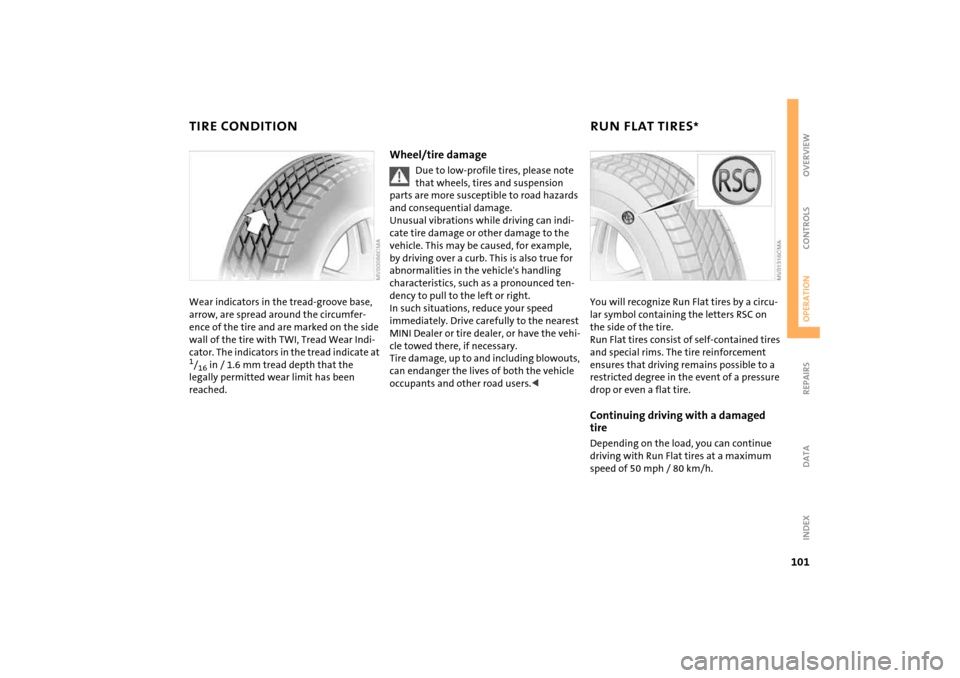
101
OVERVIEW REPAIRSOPERATIONCONTROLS DATA INDEX
TIRE CONDITION
RUN FLAT TIRES
*
Wear indicators in the tread-groove base, arrow, are spread around the circumfer
-
ence of the tire and are marked on the side
wall of the tire with TWI, Tread Wear Indi
-
cator. The indicators in the tread indicate at 1/16 in / 1.6
mm tread depth that the
legally permitted wear limit has been
reached.
Wheel/tire damage
Due to low-profile tires, please note that wheels, tires and suspension
parts are more susceptible to road hazards
and consequential damage.
Unusual vibrations while driving can indi
-
cate tire damage or other damage to the
vehicle. This may be caused, for example,
by driving over a curb. This is also true for
abnormalities in the vehicle's handling
characteristics, such as a pronounced ten
-
dency to pull to the left or right.
In such situations, reduce your speed
immediately. Drive carefully to the nearest
MINI Dealer or tire dealer, or have the vehi
-
cle towed there, if necessary.
Tire damage, up to and including blowouts,
can endanger the lives of both the vehicle
occupants and other road users.<
You will recognize Run Flat tires by a circu
-
lar symbol containing the letters RSC on
the side of the tire.
Run Flat tires consist of self-contained tires
and special rims. The tire reinforcement
ensures that driving remains possible to a
restricted degree in the event of a pressure
drop or even a flat tire. Continuing driving with a damaged
tire Depending on the load, you can continue
driving with Run Flat tires at a maximum
speed of 50
mph
/ 80
km/h.
Page 104 of 165

102
RUN FLAT TIRES
*
NEW WHEELS AND TIRES
If there is a total loss of tire inflation pres
-
sure, 0
psi
/ 0 kPa, or obvious tire damage,
you can gauge the mileage for continued
driving on the basis of the following indica
-
tions:>With a light load:
1 to 2 persons without luggage:
approx. 155
miles
/ 250
km
>With a medium load:
2 persons, full luggage compartment, or
4 persons without luggage:
approx. 90 miles
/ 150 km.
>With a full load:
4 persons or more, full luggage compart
-
ment:
approx. 30
miles
/ 50 km.
Drive cautiously. Do not exceed a speed of 50
mph
/ 80
km/h. In case of
tire pressure loss you must expect changes
in vehicle handling such as lower track sta
-
bility during braking, longer braking dis
-
tances and changes in self-steering proper
-
ties when close to the handling limit.
For safety reasons, the manufacturer of
your vehicle recommends not having dam
-
aged Run Flat tires repaired. In this case,
consult your MINI dealer.<
Tire change set
In case of a flat tire, the tire change set is not needed, since your vehicle
has Run Flat tires.
When changing a tire, always observe the
safety measures and the procedure for
changing tires starting on page
125
.<
Your vehicle is additionally equipped with a
tire change set.In the MINI COOPER and MINI COOPER Con
-
vertible this is located in the luggage com
-
partment under the floor mat.
In the MINI COOPER
S and MINI COOPER S
Convertible, the tire change set is located in
a separate bag which is attached to the
lashing eyelets on the luggage compart
-
ment floor by means of tie-down straps.
Have new wheels and tires mounted only by a tire specialist. Work that is
improperly carried out could result in con
-
sequential damage and pose safety haz
-
ards.
-
tion for your vehicle.
Have the wheels balanced after each tire or
wheel replacement. The correct wheel and tire combination is
also important for various systems that
would otherwise be impaired, e.g. ABS or
DSC.
The manufacturer of your vehicle rec
-
ommends that you avoid using
retread tires, as this could impair driving
safety. This is due to the possible variations
in casing structures and, in some cases, to
their extreme age, which can lead to a
decrease in their durability.<
Page 105 of 165
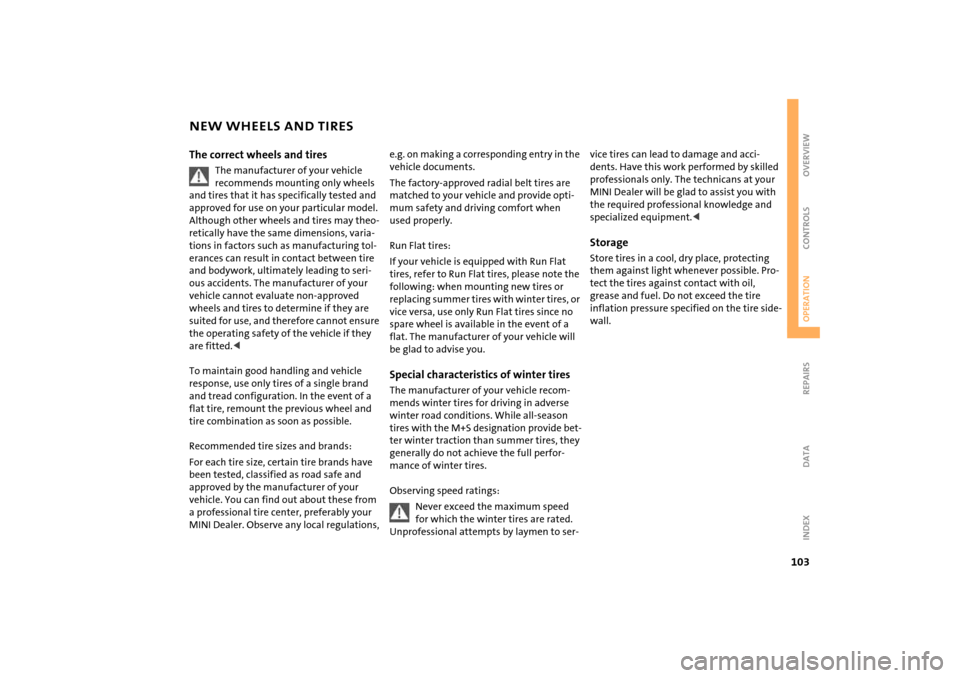
103
OVERVIEW REPAIRSOPERATIONCONTROLS DATA INDEX
NEW WHEELS AND TIRESThe correct wheels and tires
The manufacturer of your vehicle
recommends mounting only wheels
and tires that it has specifically tested and
approved for use on your particular model.
Although other wheels and tires may theo
-
retically have the same dimensions, varia
-
tions in factors such as manufacturing tol
-
erances can result in contact between tire
and bodywork, ultimately leading to seri
-
ous accidents. The manufacturer of your
vehicle cannot evaluate non-approved
wheels and tires to determine if they are
suited for use, and therefore cannot ensure
the operating safety of the vehicle if they
are fitted.
and tread configuration. In the event of a
flat tire, remount the previous wheel and
tire combination as soon as possible.Recommended tire sizes and brands:For each tire size, certain tire brands have
been tested, classified as road safe and
approved by the manufacturer of your
vehicle. You can find out about these from
a professional tire center, preferably your
MINI Dealer. Observe any local regulations,
e.g. on making a corresponding entry in the
vehicle documents. The factory-approved radial belt tires are
matched to your vehicle and provide opti
-
mum safety and driving comfort when
used properly.Run Flat tires:If your vehicle is equipped with Run Flat
tires, refer to Run Flat tires, please note the
following: when mounting new tires or
replacing summer tires with winter tires, or
vice versa, use only Run Flat tires since no
spare wheel is available in the event of a
flat. The manufacturer of your vehicle will
be glad to advise you.Special characteristics of winter tires The manufacturer of your vehicle recom
-
mends winter tires for driving in adverse
winter road conditions. While all-season
tires with the M+S designation provide bet
-
ter winter traction than summer tires, they
generally do not achieve the full perfor
-
mance of winter tires. Observing speed ratings:
Never exceed the maximum speed for which the winter tires are rated.
Unprofessional attempts by laymen to ser
-
vice tires can lead to damage and acci
-
dents. Have this work performed by skilled
professionals only. The technicans at your
MINI Dealer will be glad to assist you with
the required professional knowledge and
specialized equipment.
-
tect the tires against contact with oil,
grease and fuel. Do not exceed the tire
inflation pressure specified on the tire side
-
wall.
Page 122 of 165
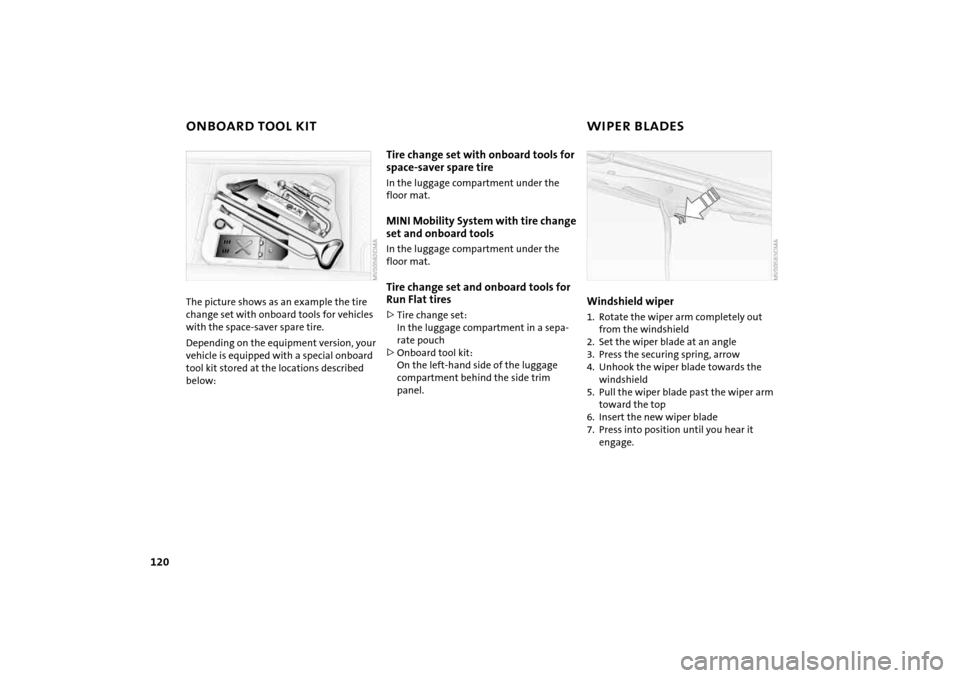
120
ONBOARD TOOL KIT
WIPER BLADES
The picture shows as an example the tire change set with onboard tools for vehicles
with the space-saver spare tire.Depending on the equipment version, your
vehicle is equipped with a special onboard
tool kit stored at the locations described
below:
Tire change set with onboard tools for
space-saver spare tireIn the luggage compartment under the
floor mat.MINI Mobility System with tire change
set and onboard tools In the luggage compartment under the
floor mat.Tire change set and onboard tools for
Run Flat tires >Tire change set:
In the luggage compartment in a sepa
-
rate pouch>Onboard tool kit:
On the left-hand side of the luggage
compartment behind the side trim
panel.
Windshield wiper1. Rotate the wiper arm completely out
from the windshield 2. Set the wiper blade at an angle3. Press the securing spring, arrow4. Unhook the wiper blade towards the
windshield5. Pull the wiper blade past the wiper arm
toward the top6. Insert the new wiper blade7. Press into position until you hear it
engage.
Page 127 of 165
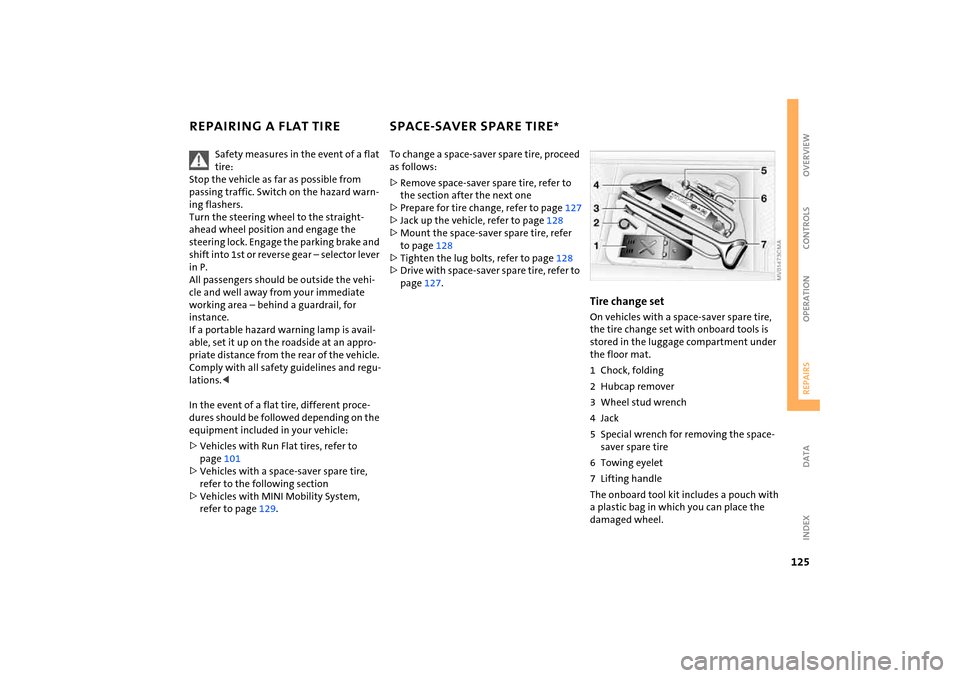
125
OVERVIEW REPAIRSOPERATION CONTROLS DATA INDEX
REPAIRING A FLAT TIRE
SPACE-SAVER SPARE TIRE
*
Safety measures in the event of a flat tire:
Stop the vehicle as far as possible from
passing traffic. Switch on the hazard warn
-
ing flashers.
Turn the steering wheel to the straight-
ahead wheel position and engage the
steering lock. Engage the parking brake and
shift into 1st or reverse gear – selector lever
in P.
All passengers should be outside the vehi
-
cle and well away from your immediate
working area – behind a guardrail, for
instance.
If a portable hazard warning lamp is avail
-
able, set it up on the roadside at an appro
-
priate distance from the rear of the vehicle.
Comply with all safety guidelines and regu
-
lations.
dures should be followed depending on the
equipment included in your vehicle:>Vehicles with Run Flat tires, refer to
page
101
>Vehicles with a space-saver spare tire,
refer to the following section>Vehicles with MINI Mobility System,
refer to page
129
.
To change a space-saver spare tire, proceed
as follows:>Remove space-saver spare tire, refer to
the section after the next one>Prepare for tire change, refer to page
127
>Jack up the vehicle, refer to page
128
>Mount the space-saver spare tire, refer
to page
128
>Tighten the lug bolts, refer to page
128
>Drive with space-saver spare tire, refer to
page
127
.
Tire change setOn vehicles with a space-saver spare tire,
the tire change set with onboard tools is
stored in the luggage compartment under
the floor mat.1 Chock, folding2 Hubcap remover3 Wheel stud wrench4Jack5 Special wrench for removing the space-
saver spare tire6 Towing eyelet7 Lifting handleThe onboard tool kit includes a pouch with
a plastic bag in which you can place the
damaged wheel.